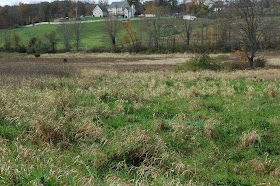No gates blocked the entrance and the property was unposted, so we drove in. Odd that neither Ivan nor I had ever heard of the place, considering our combined knowledge of the state and what I thought was a pretty comprehensive understanding of NJAES properties. How did this one get past us?
 We drove up the hill on a narrow country road until we saw what can best be described as a complete farm: barn, stable, house, you name it. Various signs indicated the property's last use as a 4H facility, and the vestiges of a summer camp, including an infirmary and staff housing, came into view. We parked next to one of the buildings and got out to take a look.
We drove up the hill on a narrow country road until we saw what can best be described as a complete farm: barn, stable, house, you name it. Various signs indicated the property's last use as a 4H facility, and the vestiges of a summer camp, including an infirmary and staff housing, came into view. We parked next to one of the buildings and got out to take a look. A nearby bulletin board told us that Lusscroft is now part of High Point State Park, but it still holds farming ties through an association with the State Agricultural Development Committee. As we looked around, the place got a bit less deserted looking -- a late-model pickup truck or two were parked near the buildings, and an occasional vehicle would drive by, perhaps on the way to another part of the state park. Plus, the bulletin board announced a winter holiday event to take place in early December. Clearly people were keeping an eye on the place, and hopefully doing something to revive activity there.
A nearby bulletin board told us that Lusscroft is now part of High Point State Park, but it still holds farming ties through an association with the State Agricultural Development Committee. As we looked around, the place got a bit less deserted looking -- a late-model pickup truck or two were parked near the buildings, and an occasional vehicle would drive by, perhaps on the way to another part of the state park. Plus, the bulletin board announced a winter holiday event to take place in early December. Clearly people were keeping an eye on the place, and hopefully doing something to revive activity there.Later on, I visited Lusscroft's website and discovered there's a Heritage and Agriculture Association working to stabilize and ultimately restore the existing buildings. Their vision is to create a place where people can learn about farming, forestry and New Jersey's agricultural heritage, and I couldn't think of a better place to do it. The property is beautiful, with hills and dales, forest and meadow, and it would be a great place to spend a few days in the countryside. Equestrians can also take advantage of the stables there, it appears; the site notes that Lusscroft is the only state park facility to accommodate horses. Meanwhile, they're holding occasional events at the farm, including maple sugaring from the trees on site.
Who knows? The revived Lusscroft could also reclaim status as a productive research facility. Back in the '30's, the farm was the first place in the world where cattle were artificially inseminated in the hopes of improving dairy stock. Even if it just opens peoples' eyes to the history and future of farming in New Jersey, Lusscroft will have made a big impact yet again.




















